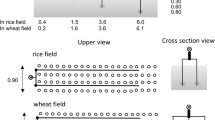Abstract
Water use and plant growth and quality were compared across different nursery stock beds, different methods of applying irrigation, and different methods of scheduling irrigation. With overhead irrigation, scheduling of irrigation according to plant demand, along with an irrigation system designed to maximise irrigation uniformity, resulted in substantial water savings, without reducing plant quality. This was the case in both wet and dry years. In the dry year, plant quality was particularly good when grown on a sub-irrigated sand bed; this system also used less water than any of the overhead irrigation systems. Two different systems were effective in scheduling overhead irrigation, one based on the volumetric moisture in the growing substrate, and the other based on plant evapotranspiration. The latter was determined with a small sensor with wet and dry artificial “leaves”, the output of which correlated with that obtained following the Penman–Monteith method based on a full set of meteorological data.









Similar content being viewed by others
References
Allen RG (2000) REF-ET Reference Evapotranspiration Calculator. Version Windows 2.0. University of Idaho, Kimberley
Allen RG, Jensen ME, Wright JL, Burman RD (1989) Operational estimates of reference evapotranspiration. Agron J 81:650–662
Beeson RC Jr (2004) Modeling actual evapotranspiration of Ligustrum japonicum from rooted cuttings to commercially marketable plants in 12 liter black polyethylene containers. Acta Hortic (ISHS) 664:71–77
Beeson RC Jr (2005) Modeling irrigation requirements for landscape ornamentals. Horttechnology 15:18–22
Beeson RC Jr (2006) Relationship of plant growth and actual evapotranspiration to irrigation frequency based on management allowed deficits for container nursery stock. J Am Soc Hortsci 131:140–148
Beeson RC Jr, Knox GW (1991) Analysis of efficiency of overhead irrigation in container production. HortScience 26:848–850
Beeson RC Jr, Yeager TH (2003) Plant canopy affects sprinkler irrigation application efficiency of container-grown ornamentals. HortScience 38:1373–1377
Beeson RC Jr, Brooks J (2007) Evaluation of a model based on reference crop evapotranspiration (ETo) for precision irrigation using overhead sprinklers during nursery production of Ligustrum japonica. Acta Hortic (in press)
Briercliffe T, Hewson A, Brough W (2000) Independent water audits for container grown nursery stock producers. Summary report for MAFF Water audits
Bunt AC (1988) Media and mixes for container-grown plants, 2nd edn. Unwin Hyman, London
Cameron RWF, Harrison-Murray RS, Atkinson CJ, Judd HL (2006) Regulated deficit irrigation–a means to control growth in woody ornamentals. J Hort Sci Biotech 81:435–443
Charlesworth PB (2005) Irrigation Insights No. 1—soil water monitoring. National Program for Irrigation Research and Development, 2nd edn. CSIRO Publishing, Melbourne
Costa JM, Ortuña MF, Chaves MM (2007) Deficit irrigation as a strategy to save water: physiology and potential application to horticulture. J Integr Plant Biol 49:1421–1434
Goodwin PB, Murphy M, Melville P, Yiasoumi W (2003) Efficiency of water and nutrient use in containerised plants irrigated by overhead, drip or capillary irrigation. Aust J Exp Agr 43:189–194
Grant OM, Stoll M, Jones HG (2004) Partial rootzone drying does not affect fruit yields of raspberries. J Hort Sci Biotech 79:125–130
Grant OM, Chaves MM, Jones HG (2006) Optimizing thermal imaging as a technique for detecting stomatal closure induced by drought stress under greenhouse conditions. Physiol Plantarum 127:507–518
Harris GL, Hodgkinson RA, Scott M, Mason DJ, Pepper TJ (1997) Impact of hardy ornamental nursery stock (HONS) systems on the environment: losses of nutrients and agrochemicals. Agric Water Manage 34:95–110
Harrison-Murray RS (1991a) A leaf-model evaporimeter for estimating potential transpiration in propagation environments. J Hort Sci 66:131–139
Harrison-Murray RS (1991b) An electrical sensor for potential transpiration: principle and prototype. J Hort Sci 66:141–149
Henson DY, Newman SE, Hartley DE (2006) Performance of selected herbaceous annual ornamentals grown at decreasing levels of irrigation. HortScience 41:1481–1486
Irmak S (2005) Crop evapotranspiration and crop coefficients of Viburnum odoratissimum (Ker.-Gawl). Appl Eng Agric 21:371–381
Jones HG (2004) Irrigation scheduling: advantages and pitfalls of plant-based methods. J Exp Bot 55:2427–2436
Lloyd JE, Herms DA, Rose MA, Van Wagoner J (2006) Fertilization rate and irrigation scheduling in the nursery influence growth, insect performance, and stress tolerance of “Sutyzam” crabapple in the landscape. HortScience 41:442–445
dos Santos TP, Lopes CM, Rodriguez ML, de Souza CR, Maroco JP, Pereira JS, Silva JR, Chaves MM (2003) Partial rootzone drying: effects on growth and fruit quality of field-grown grapevines (Vitis vinifera). Funct Plant Biol 30:663–671
Stanley CD, Harbaugh BK (1988) Estimated poinsettia crop water requirements based on evaporative demand and plant growth characteristics. HortScience 23:66 (024 PS I-A)
Stirzaker RJ (2003) When to turn the water off: scheduling micro-irrigation with a wetting front detector. Irrig Sci 22:177–185
Stirzaker RJ (2005) Managing irrigation with a wetting front detector. UK Irrig 33:22–24
Stirzaker RJ, Hutchinson PA (2005) Irrigation controlled by a wetting front detector: field evaluation under sprinkler irrigation. Aust J Soil Res 43:935–943
Acknowledgments
We would like to acknowledge the advice of the steering group of HDC HNS project 122, the helpful comments provided by an anonymous reviewer, and the assistance of the EMR facilities team. This research was funded by the Horticultural Development Council.
Author information
Authors and Affiliations
Corresponding author
Additional information
Communicated by E. Fereres.
Rights and permissions
About this article
Cite this article
Grant, O.M., Davies, M.J., Longbottom, H. et al. Irrigation scheduling and irrigation systems: optimising irrigation efficiency for container ornamental shrubs. Irrig Sci 27, 139–153 (2009). https://doi.org/10.1007/s00271-008-0128-x
Received:
Accepted:
Published:
Issue Date:
DOI: https://doi.org/10.1007/s00271-008-0128-x




